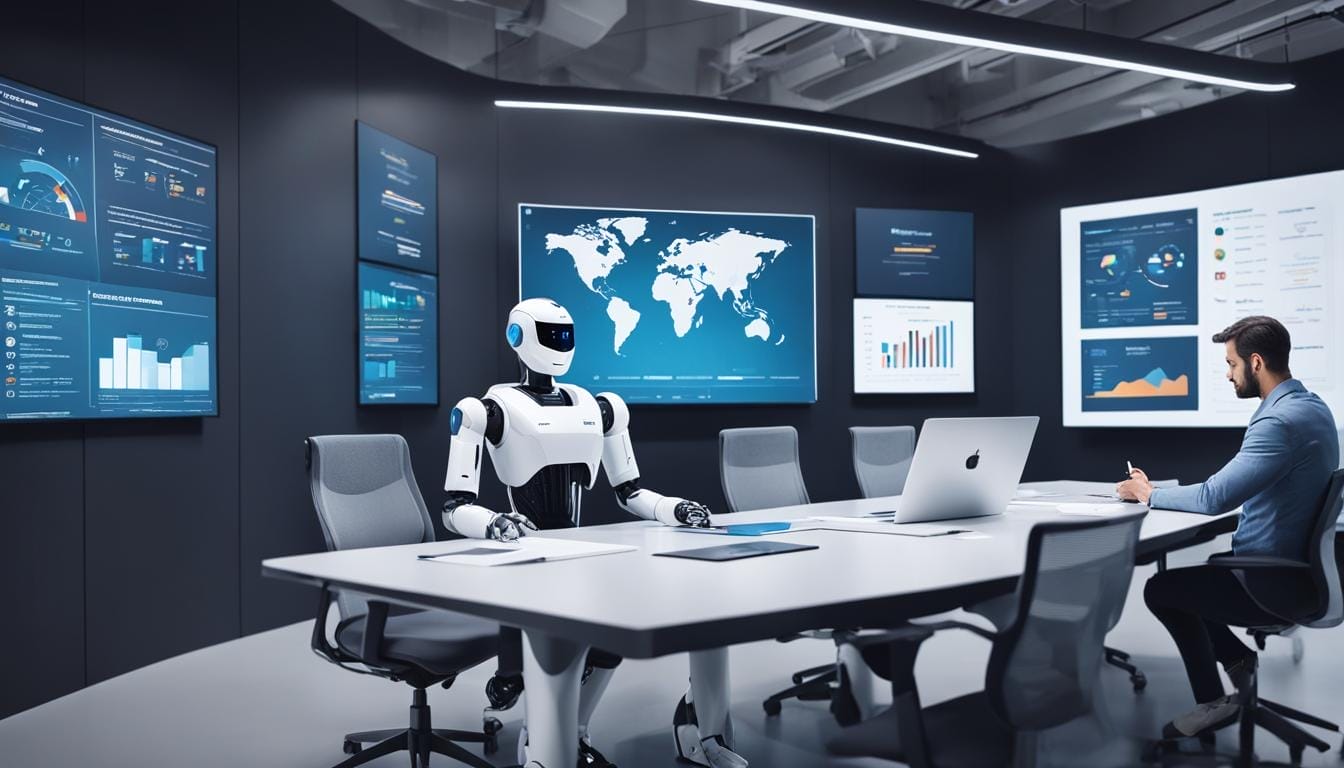In today’s rapidly evolving digital landscape, virtual talent management has become an essential component of organizations’ success. As companies increasingly embrace remote work and virtual collaboration, effectively managing a remote workforce has become paramount.
Digital talent management strategies are shaping the future of HR practices, enabling organizations to identify, nurture, and retain talent in virtual team settings. Leveraging technology and data-driven insights, companies can optimize their talent acquisition, development, and retention processes, ultimately driving productivity and employee satisfaction.
This article explores the key factors driving the evolution of virtual talent management and provides valuable case studies and expert insights to help organizations navigate the digital era successfully.
Key Takeaways:
- Implement digital recruitment strategies using social media sourcing and online job platforms to tap into a broader pool of talent.
- Utilize AI and automation in talent acquisition to streamline processes, reduce bias, and increase diversity.
- Embrace data-driven decision-making through workforce analytics to inform talent management strategies and enhance productivity.
- Explore the gig economy and leverage talent pools to gain agility and access a diverse range of skills.
- Focus on employer branding to attract and retain top talent by emphasizing company culture and reputation.
With the right strategies and technology in place, organizations can embrace virtual talent management and thrive in the digital era, unlocking new opportunities for growth and success.
Digital Recruitment Strategies
In today’s digital age, companies are employing innovative digital recruitment strategies to attract and hire top talent. With the widespread use of social media, professional networking sites, and online job platforms, organizations can tap into a broader pool of candidates while streamlining the screening process.
One highly successful digital recruitment strategy is leveraging social media for sourcing talent. Platforms like LinkedIn, Facebook, and Twitter allow companies to connect with potential candidates directly, reaching a large audience of professionals actively looking for career opportunities. By crafting compelling and engaging employer branding content, companies can capture the attention of passive candidates and showcase their unique value proposition.
Siemens, a global technology company, effectively utilized LinkedIn to find and engage top-tier passive candidates. By creating a strong employer brand presence on the platform, Siemens attracted professionals who aligned with their corporate culture, values, and goals. This approach not only expanded their talent pool but also ensured that they were attracting candidates who were a good cultural fit for the organization.
Online job platforms also play a crucial role in digital recruitment strategies. These platforms provide companies with access to a vast network of job seekers, making it easier to find qualified candidates for specific roles. Job platforms offer advanced search filters and algorithms that match job requirements with candidate profiles, saving HR professionals valuable time and effort.
| Platform | Features | Benefits |
|---|---|---|
| Indeed | – Broad reach – Advanced search options – Resume database |
– Access to a large pool of active job seekers – Efficient filtering and screening of candidates |
| – Professional networking – Job postings – Talent search |
– Targeted reach to professionals with specific skills – Access to passive candidates – Employer branding opportunities |
|
| Glassdoor | – Company reviews – Job postings – Employer branding |
– Showcase company culture and reputation – Attract candidates who align with company values – Transparent insights into the organization |
By utilizing digital recruitment strategies such as social media sourcing and online job platforms, companies can find the right candidates more efficiently and effectively. These strategies help organizations expand their reach, connect with passive candidates, and showcase their employer brand to attract top talent.
AI and Automation in Talent Acquisition
AI and automation are driving significant transformation and efficiency in talent acquisition. Companies are leveraging these technologies to analyze vast datasets, streamline decision-making processes, and save valuable time. By adopting AI-driven solutions, organizations can gain a competitive edge in talent acquisition.
Unilever’s implementation of AI in candidate screening exemplifies the benefits of this technology. It not only reduces bias but also enhances diversity by ensuring fair evaluation based on merit rather than subjective judgment. AI-driven tools enable organizations to optimize their talent pools and select the best-suited candidates for each role.
However, while AI and automation offer valuable advantages, it is crucial to strike a balance with human touchpoints to maintain candidate engagement. The seamless integration of technology and human interaction ensures a personalized experience, where candidates feel heard, valued, and supported throughout the recruitment process.
Benefits of AI and Automation in Talent Acquisition
“AI and automation revolutionize talent acquisition, enabling organizations to analyze vast datasets, streamline decision-making, and save time.”
By applying AI and automation in talent acquisition processes, companies can realize numerous benefits:
- Efficient screening and selection: AI-powered algorithms can analyze resumes, identify key qualifications, and match candidates with job requirements, significantly reducing manual effort.
- Bias reduction and diversity promotion: AI systems are designed to prioritize merit-based evaluation, helping organizations build diverse and inclusive teams.
- Data-driven decision-making: AI-driven analytics provide insights into candidate performance, enabling recruiters to make informed decisions while identifying potential gaps and improvement areas in their processes.
- Improved candidate experience: Automation allows for timely communication, personalized feedback, and streamlined scheduling, enhancing the overall candidate experience.
- Enhanced efficiency and productivity: Automating repetitive tasks allows recruiters to focus on high-value activities, such as building relationships and conducting in-depth interviews.
For a comprehensive understanding, below is a table summarizing the benefits of AI and automation in talent acquisition:
| Benefits of AI and Automation in Talent Acquisition |
|---|
| Efficient screening and selection |
| Bias reduction and diversity promotion |
| Data-driven decision-making |
| Improved candidate experience |
| Enhanced efficiency and productivity |
This table illustrates the key advantages that AI and automation bring to talent acquisition, driving increased efficiency, diversity, and data-driven decision-making.
Next, let’s explore the challenges and considerations associated with the integration of AI-driven solutions in talent acquisition.
Data-Driven Decision-Making
Big data and analytics are revolutionizing talent management, enabling organizations to make evidence-based decisions and drive strategic workforce planning. By harnessing the power of workforce analytics, HR teams can gain valuable insights into their talent pool, identify trends, and make informed talent management strategies.
One notable example of data-driven decision-making is Google’s use of people analytics to understand workforce dynamics and enhance productivity. Through the analysis of various data points, such as employee performance, engagement, and feedback, Google has been able to identify patterns and implement targeted initiatives to improve employee satisfaction and retention.
To effectively leverage data-driven decision-making in talent management, HR teams should develop expertise in data analysis and regularly review and analyze workforce data. This includes implementing robust data collection processes, utilizing advanced analytics tools, and integrating talent management systems to ensure a seamless flow of data.
By adopting a data-driven approach, organizations can optimize their talent management strategies, identify skill gaps, and align their workforce with future business needs. Data-driven decision-making allows HR professionals to make proactive talent decisions, improve employee engagement, and drive overall organizational success.
Benefits of Data-Driven Decision-Making in Talent Management
- Improved Recruitment: Workforce analytics can help HR teams identify the most effective sourcing channels, evaluate candidate fit, and reduce time-to-hire.
- Enhanced Employee Performance: By analyzing performance data, organizations can identify areas for improvement and provide targeted training and development opportunities.
- Succession Planning: Workforce analytics enable HR teams to identify high-potential employees and develop succession plans to mitigate talent gaps.
- Retention Strategies: By analyzing data related to employee engagement, satisfaction, and turnover, organizations can develop effective retention strategies.
Data-driven decision-making in talent management empowers HR teams to be proactive, strategic, and agile in managing their workforce.
Implementing data-driven decision-making requires organizations to invest in technologies, tools, and expert resources to effectively collect, analyze, and interpret data. Additionally, it is essential to ensure data privacy and security measures are in place to protect sensitive employee information.
By embracing data-driven decision-making in talent management, organizations can drive innovation, optimize talent acquisition and development, and gain a competitive edge in today’s dynamic business landscape.
The Gig Economy and Talent Pools

The gig economy has revolutionized the way organizations approach workforce management. With the rise of freelancers and part-time workers, companies now have access to a flexible talent pool that brings diverse skills and expertise to the table. One company that has effectively harnessed the power of gig workers is Airbnb.
Airbnb’s success story demonstrates the numerous benefits of tapping into gig workers. By embracing the gig economy, organizations can enhance their organizational agility and quickly adapt to changing market demands. Furthermore, the diverse range of skills offered by gig workers allows companies to access specialized knowledge and capabilities that may not be readily available within their full-time workforce.
Implementing Project-Based Contracts and Remote Work Policies
To attract high-quality gig workers, organizations should consider implementing project-based contracts and remote work policies. By offering project-based contracts, companies can provide gig workers with clear expectations and deliverables, ensuring a mutually beneficial working relationship. Remote work policies also play a crucial role in attracting gig workers, providing them with the flexibility and autonomy they need to thrive in their chosen gig opportunities.
“Organizations that embrace the gig economy and create an environment that supports gig workers will have a competitive advantage,” says John Davis, a leading expert in gig economy management.
The Benefits of a Flexible Workforce
There are several key advantages of utilizing a flexible workforce composed of gig workers:
- Cost savings: Hiring gig workers on a project basis allows organizations to optimize costs by only paying for the specific services needed.
- Access to specialized skills: Gig workers often possess niche skills and expertise that can supplement the existing capabilities of an organization.
- Increased organizational agility: With a flexible workforce, companies can quickly scale up or down based on changing market demands.
- Enhanced innovation: Gig workers bring diverse perspectives and fresh ideas, fostering a culture of innovation within the organization.
A Visual Representation of the Gig Economy and Talent Pools
Take a look at the visual representation below to understand the impact of the gig economy on talent pools:
| Talent Pool Characteristics | Gig Economy Impact |
|---|---|
| Flexible working arrangements | Increased availability of gig workers seeking project-based opportunities. |
| Access to specialized skills | Gig workers contribute niche skills and expertise to organizations. |
| Organizational agility | Flexibility allows companies to quickly adapt to market demands. |
As the gig economy continues to expand, organizations must embrace the opportunities it presents. By tapping into a talent pool of gig workers, companies can enhance their agility, access specialized skills, and drive innovation.
Emphasis on Employer Branding
With increased transparency, focusing on employer branding has become crucial for attracting and retaining top talent. A strong employer brand communicates the values, culture, and reputation of a company, enticing candidates who align with its mission and vision. By showcasing a compelling company culture and a commitment to employee well-being, organizations can differentiate themselves in a competitive talent market.
One company that exemplifies the power of employer branding is Salesforce. With its emphasis on culture, corporate social responsibility, and an employee-centric approach, Salesforce has created a positive image that resonates with job seekers. Through various channels such as social media, career portals, and internal communication platforms, Salesforce consistently communicates its values, successes, and opportunities for professional growth.
In the words of Marc Benioff, CEO of Salesforce: “Our culture is our brand, it’s the strongest asset we have. It’s built on trust, transparency, and the passionate pursuit of creating a better future both for our customers and our employees.”
An authentic employer brand not only attracts potential candidates but also enhances employee engagement and employer reputation. When employees feel aligned with the company’s values and mission, they become brand ambassadors, sharing their positive experiences and attracting other top talent. This creates a virtuous cycle, strengthening the employer brand and increasing the organization’s ability to attract and retain high-performing employees.
Building an authentic employer brand requires ongoing efforts to reinforce the desired image. Companies should regularly communicate the organization’s mission, culture, and successes through multiple channels like social media, blogs, newsletters, and employee testimonials. Highlighting employee stories and recognizing outstanding achievements also contributes to a positive employer brand perception.
Elements of an Effective Employer Branding Strategy
Developing an effective employer branding strategy requires a holistic approach that incorporates different elements. Here are some key components:
- Define the company’s values and culture: Clearly articulate the core values and purpose of the organization, and ensure they align with the experiences of current employees.
- Invest in employee development and growth: Show a commitment to employee development through training programs, mentorship opportunities, and career progression plans.
- Support work-life balance: Offer flexible work arrangements, wellness programs, and initiatives that promote work-life balance.
- Encourage open communication: Foster a culture of transparency and open communication to build trust and engagement with employees.
- Showcase employee testimonials and success stories: Highlight the achievements and stories of employees to demonstrate the organization’s positive impact on careers.
Implementing an employer branding strategy helps organizations attract top talent, reduce turnover, and create a positive work environment. By building an authentic and compelling employer brand, companies can differentiate themselves and become employers of choice in their industry.
Remote Work Revolution
The COVID-19 pandemic has brought about a rapid transformation in the way we work. Organizations have had to swiftly adapt to remote work models, leading to a revolution in the way talent is managed. With remote work becoming the new normal, businesses are restructuring their talent management strategies to effectively manage a distributed workforce.
One company that has embraced remote work wholeheartedly is Twitter. In a groundbreaking move, the social media giant announced that employees can now work remotely indefinitely. This announcement not only validates the remote work trend but also emphasizes the need for robust virtual collaboration systems to ensure seamless communication and collaboration among remote teams.
To successfully manage remote teams, organizations must implement tools and technologies that facilitate online collaboration, communication, and productivity. Virtual collaboration platforms like Slack, Microsoft Teams, and Zoom are at the forefront of enabling seamless remote communication.
“Remote work is no longer just a temporary solution; it is a fundamental shift in the way we work. Embracing virtual collaboration tools ensures that teams can connect, collaborate, and achieve their goals regardless of their physical location.”
In addition to adopting virtual collaboration tools, organizations must develop comprehensive remote work policies. These policies should support work-life balance, set clear expectations for remote employees, and outline guidelines for performance management and communication.
Companies that effectively manage a distributed workforce are reaping the rewards of increased productivity, reduced overhead costs, and access to a global talent pool. IBM, for example, has saved millions of dollars by transitioning to remote work and reducing office space requirements.
The remote work revolution has paved the way for a more flexible, inclusive, and diverse workforce. With location no longer a barrier, companies can tap into talent from around the world, creating diverse teams that bring unique perspectives and skills to the table.
Benefits of Remote Work:
- Increased productivity
- Reduced overhead costs
- Access to a global talent pool
- Improved work-life balance
- Enhanced diversity and inclusion
Organizations that embrace the remote work revolution and adapt their talent management strategies accordingly will be well-positioned to thrive in the digital age.
Advanced Employee Training using VR/AR
Virtual and augmented reality (VR/AR) technologies offer revolutionary opportunities for employee training, allowing individuals to engage in immersive learning experiences. With VR/AR, employees can practice and enhance their skills in realistic scenarios without facing real-world risks. This section explores the impact of VR/AR employee training and provides insights on how organizations can adopt these technologies effectively.
One company at the forefront of implementing immersive learning experiences is Walmart. The retail giant has successfully integrated VR technology into its customer service training programs, enabling employees to simulate various scenarios, enhance their customer interaction skills, and improve overall service quality.
“VR training has brought a new level of engagement and realism to our employee training programs. The immersive experiences allow our associates to develop crucial skills in a safe and controlled environment.” – Walmart HR Director
To fully leverage the benefits of VR/AR training, organizations should identify roles and scenarios where these technologies can have the most significant impact. Starting with pilot programs can help assess efficacy, identify areas for improvement, and scale implementation accordingly.
Additionally, integrating VR/AR technologies into employee training programs can have the following advantages:
- Enhanced skill acquisition and retention through hands-on experience
- Increased engagement and motivation among employees
- Improved knowledge transfer and application of learned concepts
- Reduced training time and costs
By embracing VR/AR employee training, organizations can unlock a new dimension of immersive learning that fosters skill development, improves employee performance, and drives organizational success.
Personalized Employee Experience

Employees in today’s digital age are looking for a personalized employee experience that goes beyond traditional HR practices. They want development opportunities tailored to their skills and goals, and rewards that recognize their contributions. One company leading the way in providing a personalized employee experience is Adobe, with its innovative “Check-In” system.
The “Check-In” system at Adobe replaces traditional performance reviews with personalized feedback and career development discussions. This approach recognizes that every employee is unique, with different strengths, aspirations, and growth areas. By focusing on individual needs, Adobe creates a more engaging and meaningful experience for its employees.
Implementing a personalized employee experience requires understanding individual employee needs and preferences. Regular surveys and AI-driven analytics can provide valuable insights into what motivates and engages employees. By leveraging data, organizations can tailor their programs and initiatives to better meet employee expectations.
Additionally, offering employees the ability to choose their benefits from a pool of options adds a personal touch to the employee experience. This approach allows individuals to select benefits that align with their specific needs and priorities, further enhancing their overall satisfaction and engagement.
Ultimately, a personalized employee experience is key to attracting and retaining top talent. It fosters a sense of belonging, shows that the organization values its employees, and provides opportunities for career development and growth. By investing in creating a personalized employee experience, organizations can create an environment where employees thrive and contribute their best work.
| Benefits of Personalized Employee Experience | Examples |
|---|---|
| Increased employee engagement |
|
| Improved talent attraction and retention |
|
| Enhanced career development opportunities |
|
Predictive Analytics in Talent Management
Predictive analytics is a powerful tool that enables HR professionals to make informed decisions and plan for the future. By leveraging HR data analysis and talent forecasting, organizations can gain valuable insights into individual employee performance and workforce trends.
One notable example of predictive analytics in action is Google’s “Work Insights” tool. This tool empowers companies to understand workforce patterns and track organizational changes, facilitating effective talent management strategies.
To harness the full potential of predictive analytics, it is essential to train HR staff in data literacy and implement technology for data collection. This ensures accurate and reliable analysis, enabling organizations to make proactive decisions that drive success.
Benefits of Predictive Analytics in Talent Management:
- Anticipate future talent needs and identify skill gaps
- Improve employee retention by predicting flight risks
- Optimize workforce planning and resource allocation
- Enhance recruitment strategies by identifying top-performing candidates
In today’s fast-paced business environment, predictive analytics is a game-changer for talent management. By utilizing data-driven insights, HR teams can stay ahead of the curve and make strategic decisions that boost organizational performance.
Implementing predictive analytics in talent management requires a combination of technological tools, skilled professionals, and a data-driven mindset. By embracing this transformative approach, organizations can unlock the full potential of their workforce and drive long-term success.
Predictive Analytics Case Studies:
| Company | Challenge | Solution |
|---|---|---|
| Microsoft | Identifying top performers and high-potential employees | Utilized predictive analytics to assess employee performance data and identify future leaders |
| IBM | Reducing employee turnover | Leveraged HR data analysis to identify factors contributing to turnover and implemented targeted retention strategies |
| Amazon | Improving workforce planning | Used talent forecasting to determine future talent needs and align recruitment efforts accordingly |
These case studies demonstrate the tangible benefits of predictive analytics in talent management. Organizations that embrace this data-driven approach gain a competitive edge in recruiting, developing, and retaining top talent.
Continuous Performance Management
In today’s fast-paced business environment, traditional annual performance reviews no longer meet the needs of organizations. Continuous performance management has emerged as a more effective approach, focusing on real-time feedback, coaching, and recognition to drive employee growth and development. By embracing this innovative talent management strategy, companies can improve employee performance, engagement, and overall organizational success.
The Benefits of Continuous Performance Management
Continuous performance management offers several advantages over traditional annual reviews:
- Real-time feedback: Employees receive timely input and guidance, enabling them to make immediate improvements and leverage their strengths.
- Coaching and development: Managers actively support employees’ professional growth by providing ongoing coaching and guidance.
- Enhanced communication: Regular performance conversations foster open dialogue between managers and employees, leading to stronger relationships and increased engagement.
- Recognition and motivation: Immediate recognition for achievements and contributions boosts employee morale and motivation.
Adopting digital tools and platforms that facilitate continuous performance management is crucial for success in today’s digital age. These tools empower managers and employees to have ongoing performance conversations, set and track goals, and provide feedback in real time.
Deloitte’s “Performance Snapshot” System
One example of an organization implementing continuous performance management is Deloitte. Their “Performance Snapshot” system emphasizes immediate insights and feedback over annual summaries. The system enables managers and employees to have regular check-ins and exchanges, fostering continuous growth and development. By shifting the focus from past performance to ongoing improvement, companies like Deloitte create a culture of continuous learning and improvement.
| Key Features | Benefits |
|---|---|
| Ongoing feedback and coaching | Improved employee performance and development |
| Real-time goal tracking | Increased visibility and alignment of individual and organizational goals |
| Recognition and rewards | Enhanced employee motivation and engagement |
| Continuous learning culture | Encourages employee growth and fosters a culture of continuous improvement |
Implementing continuous performance management requires a shift in mindset, as well as the right tools and resources to support ongoing performance conversations. By embracing this modern approach to talent management, organizations can unlock the full potential of their employees and drive sustainable success in the digital age.
Conclusion
With the digital transformation in talent management and the ever-evolving HR strategies in the digital age, organizations are presented with new opportunities and challenges. In order to stay competitive and thrive, HR teams must embrace continuous learning and digital adoption.
Talent management holds a vital position in attracting, engaging, and retaining top talent in this digital era. By leveraging digital tools, organizations can streamline their processes and enhance productivity. Furthermore, fostering a digital culture within the organization promotes innovation and collaboration.
Embracing emerging technologies such as AI, automation, and virtual reality can optimize virtual talent management strategies. The use of data-driven decision-making, predictive analytics, and continuous performance management enables better workforce planning and individual development.
In conclusion, organizations that prioritize digital transformation in talent management and implement effective HR strategies in the digital age will not only gain a competitive edge but also create a thriving work environment that fosters employee satisfaction and success.
FAQ
What is virtual talent management?
Virtual talent management refers to the process of identifying, developing, and retaining talent in a remote work setting using digital tools and technologies.
What are digital recruitment strategies?
Digital recruitment strategies involve using social media, professional networking sites, and online job platforms to attract and screen potential candidates.
How is AI used in talent acquisition?
AI is used in talent acquisition to analyze data, improve decision-making, and reduce bias in candidate screening.
What is data-driven decision-making in talent management?
Data-driven decision-making in talent management involves using workforce analytics and insights to inform strategic decisions about talent acquisition and development.
How does the gig economy impact talent management?
The gig economy creates opportunities for organizations to tap into a flexible workforce of freelancers and part-time workers, expanding access to diverse skills.
Why is employer branding important in talent management?
Employer branding is crucial in attracting and retaining top talent by showcasing the organization’s culture, values, and benefits.
How has remote work revolutionized talent management?
Remote work has necessitated the adoption of virtual collaboration tools and policies to effectively manage and engage distributed teams.
How can VR/AR be used in employee training?
Virtual and augmented reality can be used to provide immersive training experiences that simulate real-world scenarios.
What is personalized employee experience in talent management?
Personalized employee experience involves tailoring development opportunities, feedback, and rewards to meet individual employee needs.
What is predictive analytics in talent management?
Predictive analytics uses data analysis to forecast individual employee performance and workforce trends, aiding decision-making and planning.
What is continuous performance management?
Continuous performance management focuses on real-time feedback, coaching, and recognition, replacing traditional annual reviews.





